Brazoria County is the industrial heartland of the Houston area. With plenty of refineries, warehouses, utility stations, and manufacturing, a good deal of tangible wealth is built in the county. Brazoria County is not just for industrial production, however, and has some growing communities that skew more affluent, such as Angleton and Pearland. This makes the area a hybrid of Houston suburbs and independent commercial zones, allowing for a diversified population and economy. All parts of Brazoria County are attracting new residents, and the demand for living and working spaces has increased dramatically in the past decade.
As levied taxes have nearly doubled in the past decade, residents have begun flocking to property tax appeals in record numbers. As of 2023, appeal numbers and savings achieved both hit record highs, and 31.41% of all properties were protested. Protests generally come in two administrative appeal stages, with informal appeals first, followed by formal hearings with the appraisal review board (ARB). Both of these appeals are in the books and in this article, we will see just how effective they were at countering rising values and taxes.
Residential Appeals Completely Negate Many Value Rises
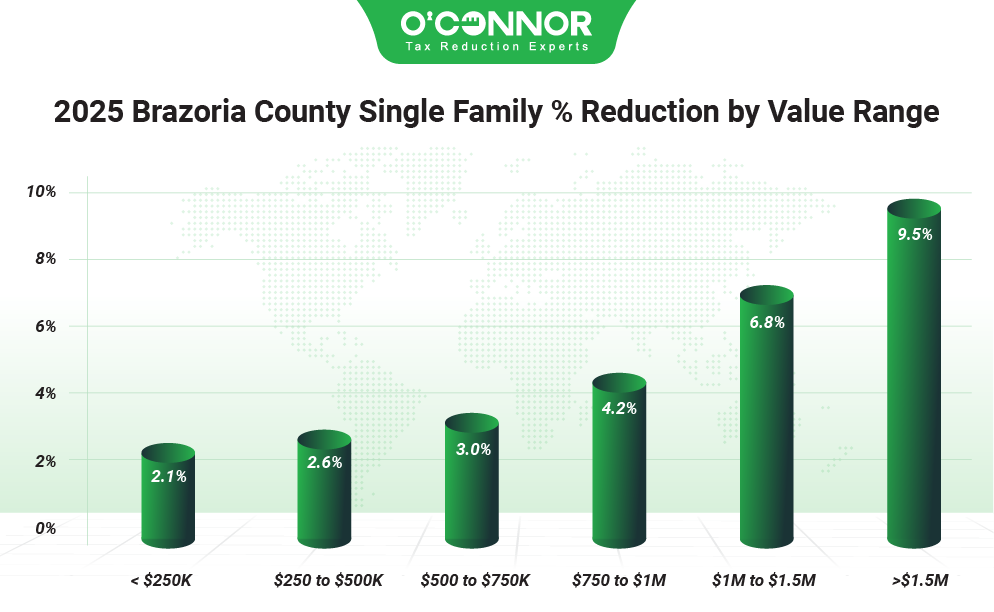
In 2025, Brazoria County saw an overall value hike of 2.9% for single family homes. While not a crazy jump like some Houston area homes saw, this was still significant. Luxury homes bore the brunt of this, with those worth over $1.5 million seeing an increase of 17.4%. When all administrative appeals were combined, much of this damage was reversed, or at least slowed. The overall total saw a reduction of 2.8%, which dropped it to $38.88 billion, just over the 2024 total of $38.62 billion. The largest subset of homes, those worth between $250,000 and $500,000, experienced a reduction of 2.6%, resulting in a final sum of $23.04 billion. Homes worth under $250,000 fell by 2.1%, while those assessed between $500,000 and $750,000 dropped 3%. Luxury homes set at over $1.5 million managed a strong decrease of 9.5%.
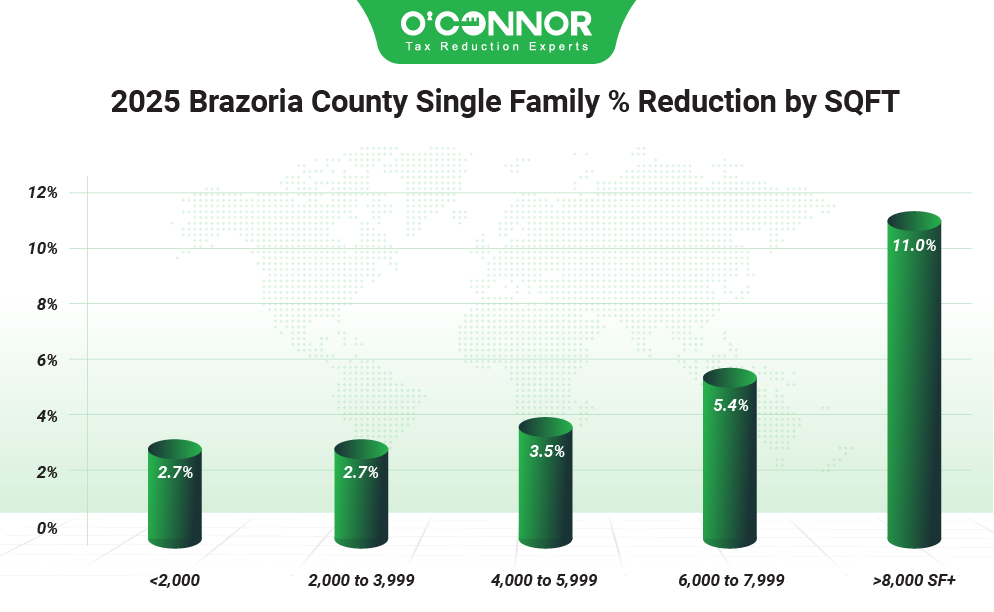
Despite the increasing value of homes, most in Brazoria County are quite modest, showcasing the working-class history of the region. $22.79 billion came from homes between 2,000 and 3,999 square feet, which followed a reduction of 2.7%. Following a cut of 2.7%, homes under 2,000 square feet managed a total of $13.15 billion. These types of homes had previously seen value increases of 3.1% and 2.1% respectively. Larger homes saved even more percentage wise, with those measured from 4,000 to 5,999 being trimmed by 3.5% thanks to appeals. Those over 8,000 square feet saved a strong 11%, nearly cutting the previous hike of 21% in half.
Breaking down homes by age of construction can provide some unique insights. The biggest category was those constructed between 2001 and 2020, which equated to $17.73 billion after an appeal culling of 2.7%. These homes had previously seen an increase of 0.8%. Those built from 1981 to 2000 saved 2.2%, resulting in a sum of $8.12 billion. Older homes built from 1961 to 1980 contributed more than most Houston area homes, reaching $5.89 billion after a reduction of 2.5%. New construction had seen an increase of 24.8% at the start of the year, but appeals were able to block some of this, resulting in a decrease of 4.9%. New construction contributed $4.48 billion to the total.
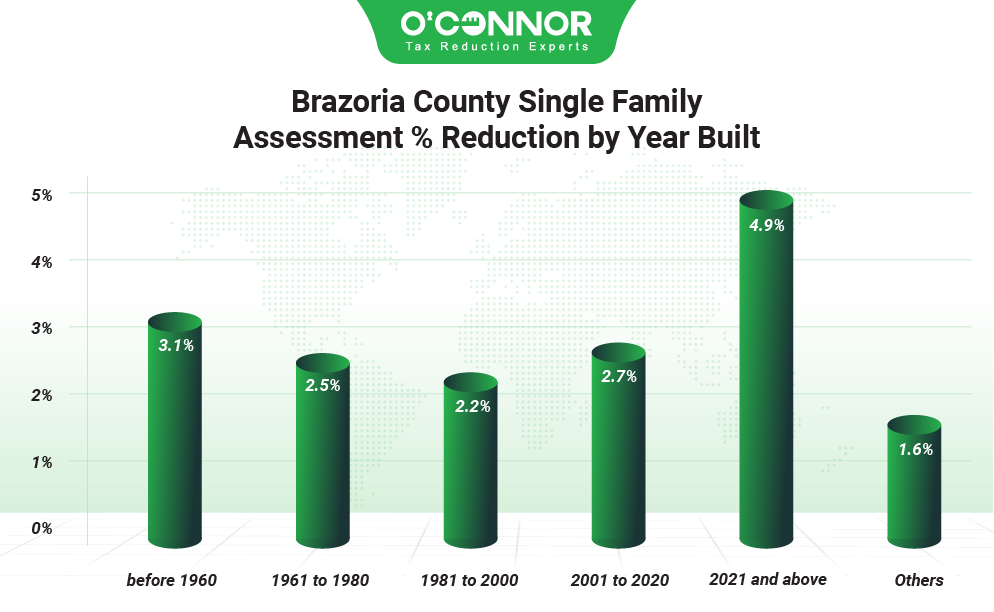
Breaking down homes by age of construction can provide some unique insights. The biggest category was those constructed between 2001 and 2020, which equated to $17.73 billion after an appeal culling of 2.7%. These homes had previously seen an increase of 0.8%. Those built from 1981 to 2000 saved 2.2%, resulting in a sum of $8.12 billion. Older homes built from 1961 to 1980 contributed more than most Houston area homes, reaching $5.89 billion after a reduction of 2.5%. New construction had seen an increase of 24.8% at the start of the year, but appeals were able to block some of this, resulting in a decrease of 4.9%. New construction contributed $4.48 billion to the total.
Taxpayers That Joined O’Connor Saved 22% on Their Commercial Properties
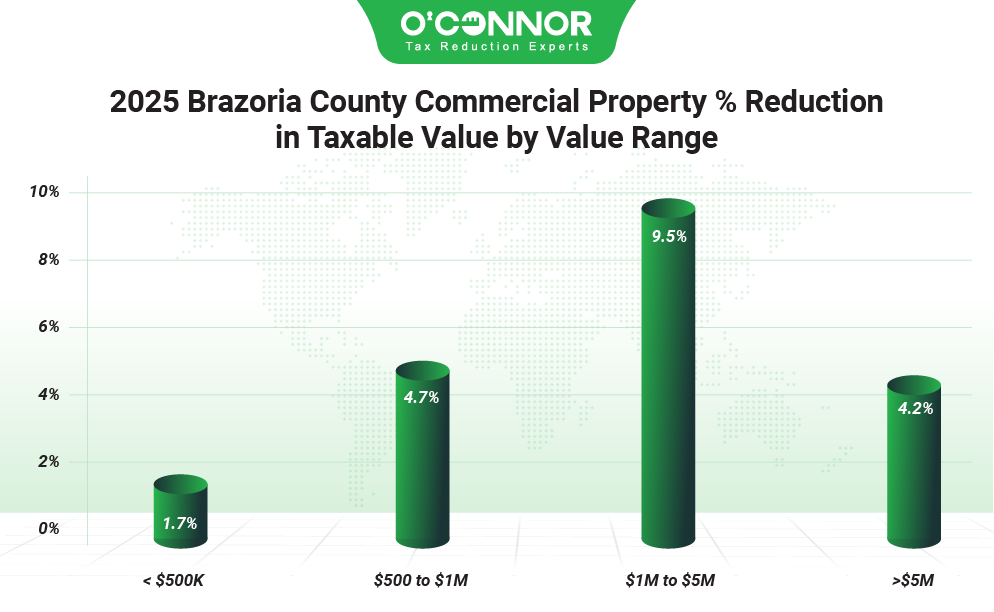
Commercial properties are the beating heart of Brazoria County. These reached a 2025 total of $35.94 billion after an increase of 3.4%. As these are typically appealed every year, the properties quickly saw a decrease of 4.5%, totally wiping out the overall gain. Much of the gains and cuts were focused on those properties worth over $5 million, which were responsible for $30.51 billion at the start of the year. These were chopped down by 4.2% thanks to appeals, which meant a new total of $29.24 billion. Commercial properties worth between $1 million and $5 million got a sizeable cut of 9.5%. Businesses that used O’Connor for their appeals saw an overall cut of 22%, with those worth over $5 million dropping by 26.8%.
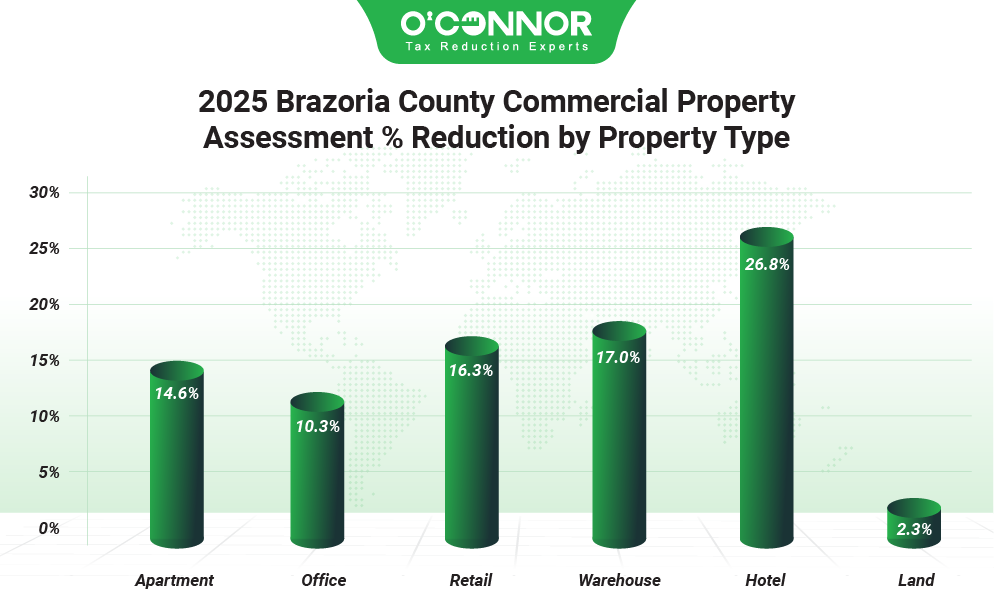
Since Brazoria CAD does not classify industrial, oil, or utilities as commercial property, then the largest single category for business real estate is raw land. Valued at $29.02 billion after an appellant reduction of 2.3%, this vacant land demonstrates limitless potential. Apartments were in the No. 2 slot after a cut of 14.6%, which checked a large increase of 15.5%, with the final sum being $2.21 billion. Retail saw a spike of 18.6%, but this was confronted by a reduction of 16.3%. With a decrease of 10.3%, offices managed to partially fend off an increase of 19.8%. Hotels saw the largest jump by far, with 33.1%. This was met by an astounding reduction of 26.8%.
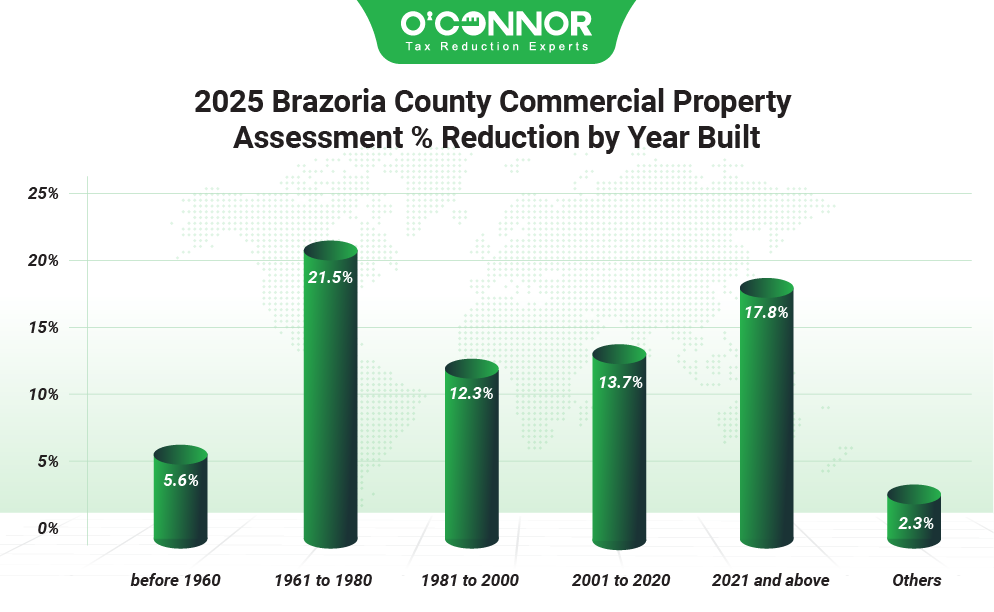
When looked at by time of construction, the largest block is those built from 2001 to 2020, with a total of $2.82 billion after a reduction of 13.7%. These business properties had increased by 15.2%, so appeals made a real difference. Like homes, the second and third place properties were built between 1981 and 2000, and 1961 and 1980 respectively. These saw reductions of 12.8% and 21.5%, countering increases of 15.5% and 26%. New construction had seen the largest increase, naturally, with a spike of 29.8%. This was slowed thanks to an appeal barrage that dropped it by 17.8% for a total of $510.51 million. The “other” category was for raw land.
Brazoria Apartments Values Fall 14.5% Thanks to Appeals
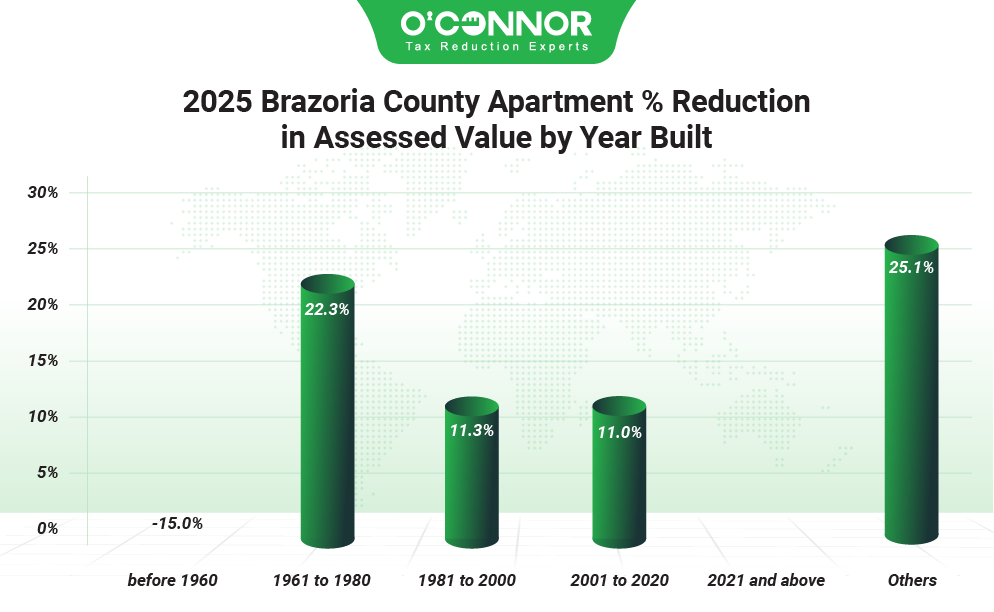
Like most Texas counties, Brazoria’s No. 1 commercial property, outside of raw land, is apartments. These totaled $2.58 billion before appeals and $2.21 billion after a large decrease of 14.6% after appeals. This was in answer to an increase of 15.5%. Apartments built between 2001 and 2020 were responsible for 53.2% of all value, translating into $1.18 billion after a cut of 11%. Those from 1981 to 2000 reached $436.42 million after a reduction of 11.3%, while those built from 1961 to 1980 totaled $428.02 million following a slashing of 22.3%. New construction was the fastest riser with a spike of 33.1%, though this was somewhat derailed by a huge appellant reduction of 25.1%. Apartment owners that chose O’Connor got an overall reduction of 19.5%, including an 18.2% trimming for those built from 2001 to 2020.
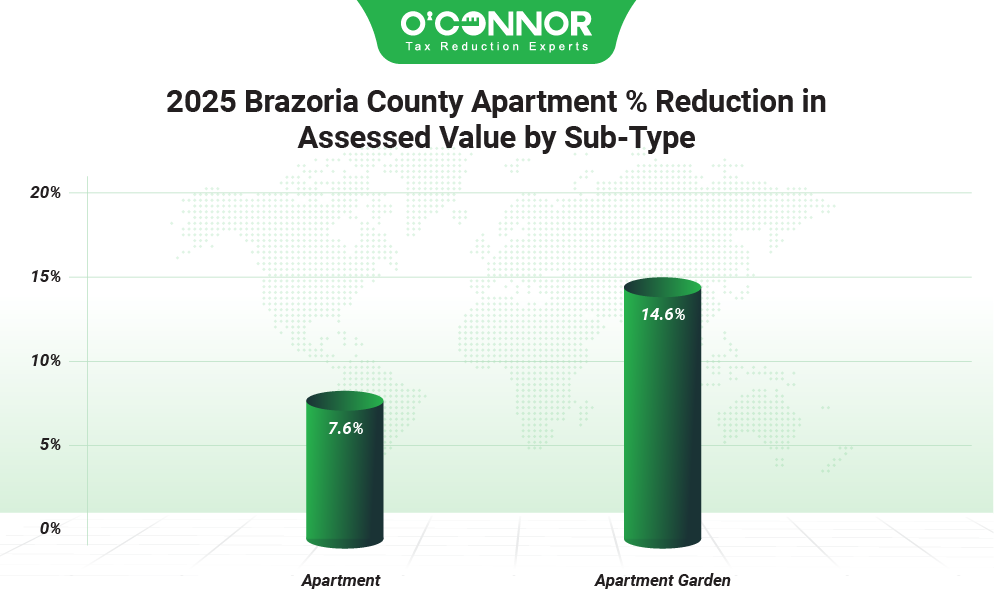
Apartments were only divided into two types by Brazoria CAD. High-rise apartments were responsible for $2.21 billion after a decrease of 14.6%. Generic apartments were accountable for a fraction of high-rises, with a sum of $5.52 million following a reduction of 7.6%.
Offices Were Reduced by 10.3% After an Increase of 19.8%
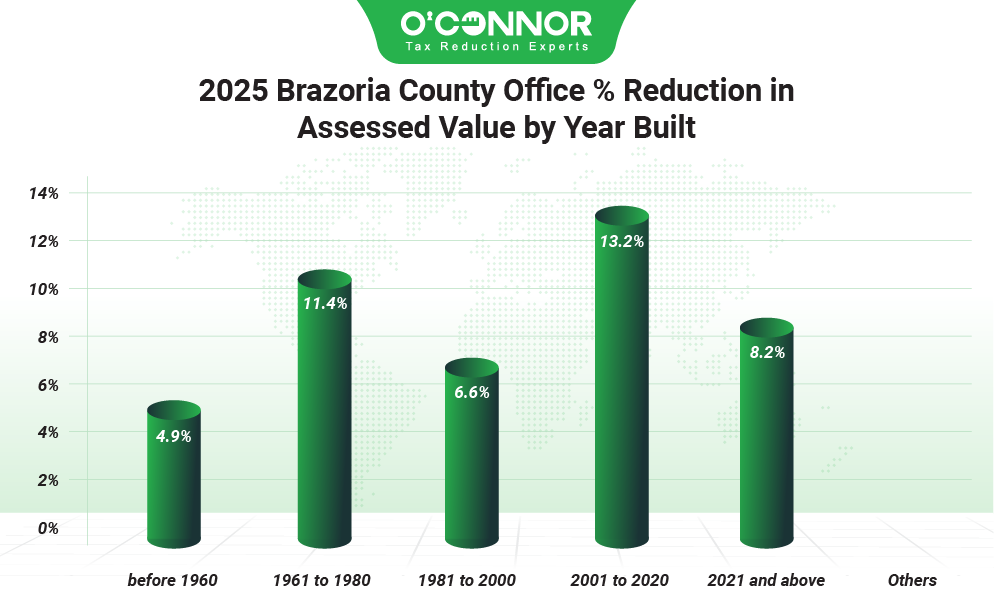
Offices started 2025 by getting hammered with an increase of 19.8% by Brazoria CAD. Thanks to a combination of informal and formal protests, this was lowered by 10.3%, resulting in a total of $1.07 billion. Like other properties, most of the value came from those built between 2001 and 2020, with these reaching a total of $466.29 million after a reduction of 13.2%. Offices constructed from 1981 to 2000 were in the No. 2 slot following a cut of 6.6%, which resulted in a sum of $268.26 million. New construction did capture more of the total than most other properties and accounted for 17.8% of the whole. New construction had risen a staggering 27.5% but appeals knocked off 8.2%. When clients partnered with O’Connor, they were able to see an overall reduction of 17.1%.
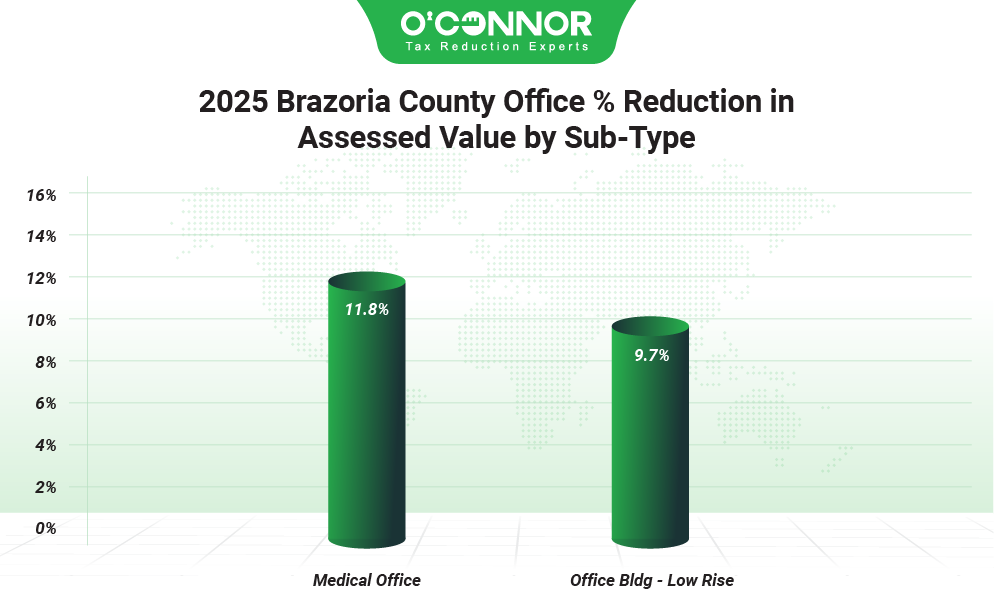
Like apartments, there were only two official categories of offices. Low-rise offices had most of the value locked up, controlling $771.59 million after a strong decrease of 9.7%. Medical offices saw a larger cut of 11.8%, which resulted in a total of $300.24 million.
Retail Appeals Halt Nearly All Increases
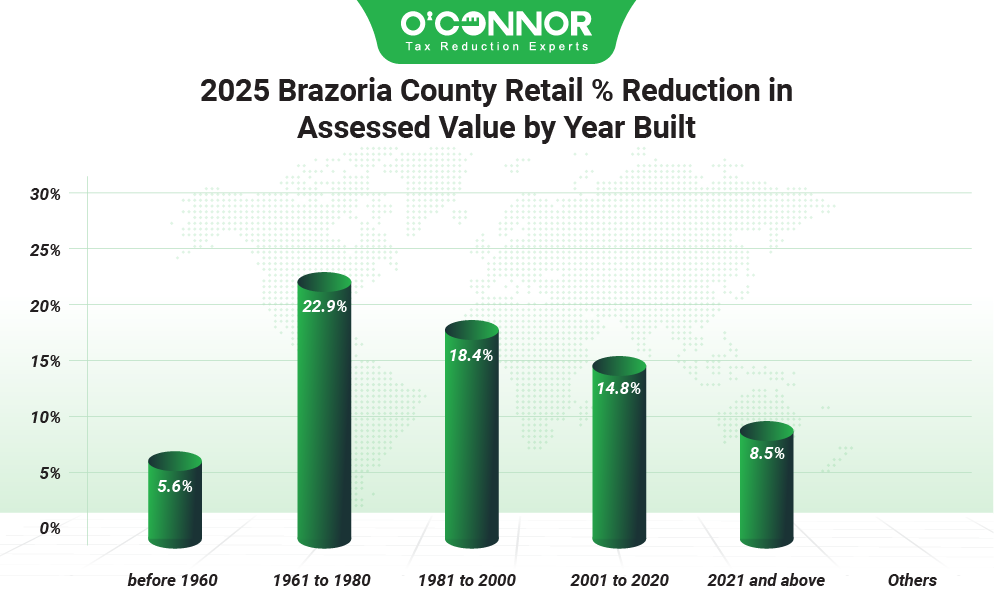
Retail spaces saw an increase of 18.6% in 2025 thanks to Brazoria CAD, but this was quickly reversed by 16.3% with appeals. The trend for age of construction certainly did not waver when it came to retail, as properties constructed between 2001 and 2020 were the most valuable. Accounting for 59.6% of all value, even after a sharp decrease of 14.8%, these stores equaled out to $898.25 million. These were followed by retail spaces built from 1961 to 1980, which landed a total of $283.14 million after a giant decrease of 22.9%. Those properties built from 1981 to 2000 were in the No. 3 spot with $177.89 million. New construction added a larger percentage of 27.5%, though this only manifested as $96.70 million after a reduction of 8.5%. O’Connor managed to improve on these numbers, landing our clients a major overall reduction of 20.1%.
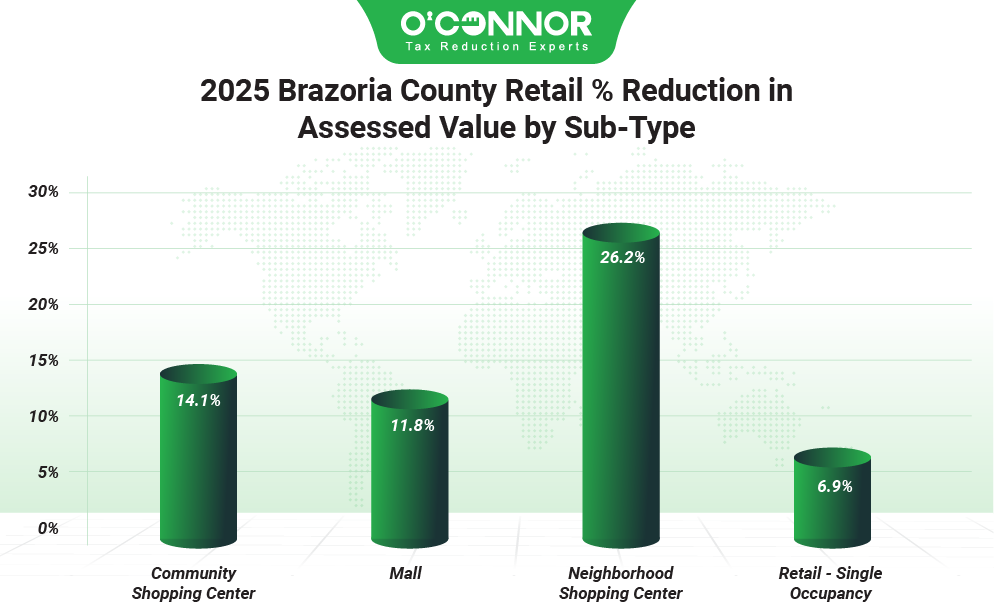
Taking No. 1 in overall value, increase percentage, and decrease percentage, neighborhood shopping centers were the mainstay of retail properties. After a huge spike of 32.2%, these giants were chopped down to size with a decrease of 26.2%, which led to a sum of $440.47 million. Malls were in second place, a rarity for Texas, and were reduced 11.8% to a total of $417.18 million. Community shopping centers were close behind with $348.93 million, while single-occupancy stores accounted for $299.96. These had been cut by 14.1% and 6/9% respectively.
Formal and Informal Appeals Shielded Properties from Out-of-Control Growth
Homeowners, especially those of smaller homes, were able to use appeals to eliminate taxable value rises in 2025. This was an impressive feat, considering Brazoria CAD believed that 31% of all homes in the county were overvalued. Appeals managed to have arguably an even greater impact on businesses. Virtually every business type saw spikes in double digits but managed to land reductions in the double digits as well. While these may not have eliminated gains like those for homes did, each percentage point usually marks millions of dollars in taxes, if not billions. High commercial values can devastate a community just as easily as residential ones can, since they usually lead to higher prices, fewer jobs, and inflated rents. These great results also show the power of having over 30% of all properties protested, as it wrangles in numbers that would otherwise have been astronomical.
We at O’Connor were able to get even better results for our clients. At 2.9% for homes and 22% for businesses, we were much better than the county numbers, especially for commercial appeals. We have been fighting Houston area CADs for over 50 years and know how best to combat rising costs. We represented over 185,000 customers in 2024 across the nation, but we always focus on Texas and the Houston area. This is because we have our headquarters in the Heights of Houston and always strive to be the best in our hometown. There is never any upfront cost to enroll with us, and you will never be ambushed by a hidden fee. We only ask for a percentage of your winnings if we can lower your taxes. We will also protest your taxes every year for you, ensuring that you are only paying what is fair.

